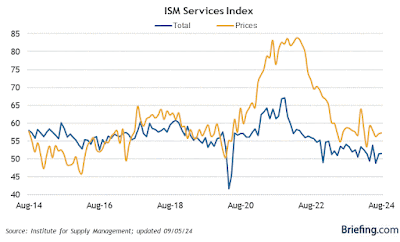– by New Deal democrat Recently I have paid much more attention to the ISM services index. That’s because, since the turn of the Millennium, manufacturing’s share of the economy has contracted to the point where even a significant decline in that index has not translated into an economy-wide recession, as for example in 2015-16. When we use an economically weighted average of the non-manufacturing index (75%) with the manufacturing index (25%), it has been a much more reliable signal, particularly when we use the 3-month average, requiring it to be below 50. Once again this month the contraction shown in the manufacturing index has been more than counterbalanced by continued expansion in the services index, which was reported at 51.5. The
Topics:
NewDealdemocrat considers the following as important: 2024, ISM indexes, US EConomics
This could be interesting, too:
NewDealdemocrat writes JOLTS revisions from Yesterday’s Report
Bill Haskell writes The North American Automobile Industry Waits for Trump and the Gov. to Act
Bill Haskell writes Families Struggle Paying for Child Care While Working
Joel Eissenberg writes Time for Senate Dems to stand up against Trump/Musk
– by New Deal democrat
Recently I have paid much more attention to the ISM services index. That’s because, since the turn of the Millennium, manufacturing’s share of the economy has contracted to the point where even a significant decline in that index has not translated into an economy-wide recession, as for example in 2015-16.
When we use an economically weighted average of the non-manufacturing index (75%) with the manufacturing index (25%), it has been a much more reliable signal, particularly when we use the 3-month average, requiring it to be below 50.
Once again this month the contraction shown in the manufacturing index has been more than counterbalanced by continued expansion in the services index, which was reported at 51.5. The more leading new orders subindex (not shown in the graph below) came in stronger, at 53.0:
Here are the last six months, including August, of both the manufacturing (left column) and non-manufacturing index (center column) numbers, and their monthly weighted average (right) :
MAR 50.3. 51.4. 51.1
APR 49.2 49.4. 49.3
MAY 48.9. 53.8. 52.5
JUN 48.5. 48.8. 48.7
JUL. 46.8. 51.4. 50.2
AUG. 47.2. 51.5 50.4
And here is the same data for the new orders components:
MAR 51.4. 54.4. 53.6
APR 49.1. 52.2. 51.4
MAY 45.4. 54.1. 51.9
JUN. 49.3 47.3. 47.8
JUL. 47.4. 52.4. 51.2
AUG. 44.6. 53.0. 50.9
Note that the single month average for both the headline and new orders components showed contraction in June, but it did not trigger a signal based on the three-month average. The current three month weighted average of the headline numbers is just below the 50.0 threshold at 49.7, while the new orders component is 49.97, which rounds to 50.0 for purposes of this analysis.
This is right on the cusp of giving a “recession warning” signal. In fact, had the new orders component of the services report been even -0.1 lower, it would have done so. Next month the poor June readings for the new orders subindex in particular go out of the average. It is quite possible that the weakness in the headline number, which is not leading, will pick up as well.
In the end, the economically weighted ISM reports show an economy which is not contracting, but in the aggregate has stalled, with contracting production being just balanced by weakly expanding services. This puts even more weight on what the leading components of the jobs report will show tomorrow.
The Bonddad Blog
ISM weighted mfg.+ non-mfg. indexes warrant hoisting a yellow caution flag for the economy, Angry Bear by New Deal democrat

